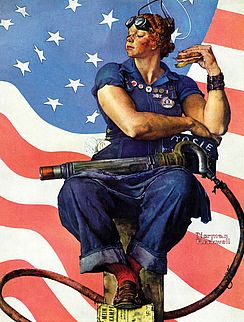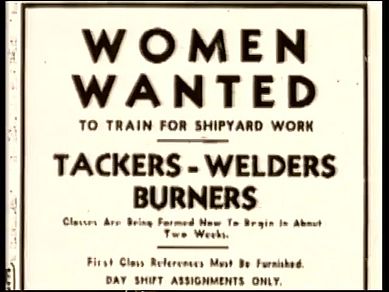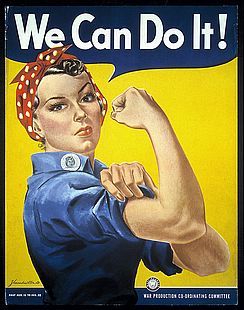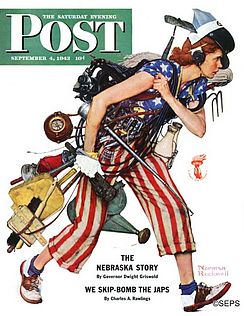Click! in the Classroom
Rosie the Riveter: Women on
the Homefront in World War II
Grade Level: Grades 6-12 | Estimated Time: One class period |
Introduction
Rosie the Riveter is one of the most iconic images from World War II. She represents women who took on industrial work for the duration of the war. Students will look at poster art to examine how women on the home front were represented as patriotic workers during World War II. They will learn about one of the most extraordinary propaganda campaigns in American history.
Learning Objectives
Students will be able to demonstrate a broad understanding of how women’s lives changed during World War II.
Students will be able to understand how wartime demands changed societal conditions and individual lives.
Essential Questions
How did the activities of home front workers in the United States contribute to the war effort during World War II?
How do citizens demonstrate their patriotism during wartime?
Materials
Computer with Speakers and Internet Access
This Lesson Plan (PDF)
- Image of Norman Rockwell’s “Rosie the Riveter” (1943), also shown above.
Meet the tradeswomen in Maine who helped build Liberty Ships during World War II.
Video, “On the Job: Women Launching a New Tradition,” by Spring Point Media Center. (Running time 27:06) Creative Commons license. The video is available from the Maine Community TV Archives.
Warm Up Activity: Film Viewing and Discussion
Show a clip from the film “On the Job: Women Launching a New Tradition” (27:06 min.), also located above.
Or, show the shorter clip from the film “Life and Times of Rosie the Riveter” (3:25 min.)Have the students discuss what they have learned about women workers during wartime.
Main Activity: Propaganda Analysis, Class Discussion, and Writing Exercise
Show the students an image of Norman Rockwell’s “Rosie the Riveter” (1943), located at the top of this lesson plan.
Ask them if they have seen the image before.
Have them describe the details in the image and explain the purpose of the image.
Lead class discussion into a short introduction of how women took on nontraditional jobs during World War II.
Have students go to Click and look at the timeline entry, “1941: U.S. Enters World War II.”
Have the students click on the link National Archive, “It’s a Woman’s War Too!”
Divide the class into four groups and have each group compare the posters. Tell them they will share their description and evaluation with the class. Guiding questions include:
Who is the audience for the posters?
How do the images and texts reinforce each other?
What are the different messages being conveyed by the posters?
How do the images help them understand patriotic war service?
Have each group discuss and write a summary of their findings.
Bring the class back together and have representatives from each group share their findings.
Have the students return to their groups. Have them click on the “Rosie to the Rescue (1943)” link in the 1941 timeline entry. Tell them that the picture contains symbols and tools depicting 31 jobs women took on when men went off to war.
Can they name the 31 occupations? (The answer is in the text, so make sure they do not read this first.)
Have them create a list of the 31 jobs.
Bring the class back together to discuss their findings.
How has looking at this new image expanded their understanding of work done by women during World War II?
Ask them to discuss the value of this work to the war effort.
Ask them to discuss how new work opportunities for women changed and challenged women and men’s lives, and society more generally.
Extension Activity
Share the lyrics of the song “Rosie the Riveter” and have students sing along.
Common Core Anchor Standards
Reading
CCSS.ELA-LITERACY.CCRA.R.7
Integrate and evaluate content presented in diverse media and formats, including visually and quantitatively, as well as in words.
Writing
CCSS.ELA-LITERACY.CCRA.W.1
Write arguments to support claims in an analysis of substantive topics or texts using valid reasoning and relevant and sufficient evidence.
Speaking and Listening
CCSS.ELA-LITERACY.CCRA.SL.2
Integrate and evaluate information presented in diverse media and formats, including visually, quantitatively, and orally.
How to Navigate our Interactive Timeline
You will find unique content in each chapter’s timeline.
Place the cursor over the timeline to scroll up and down within the timeline itself. If you place the cursor anywhere else on the page, you can scroll up and down in the whole page – but the timeline won’t scroll.
To see what’s in the timeline beyond the top or bottom of the window, use the white “dragger” located on the right edge of the timeline. (It looks like a small white disk with an up-arrow and a down-arrow attached to it.) If you click on the dragger, you can move the whole timeline up or down, so you can see more of it. If the dragger won’t move any further, then you’ve reached one end of the timeline.
Click on one of the timeline entries and it will display a short description of the subject. It may also include an image, a video, or a link to more information within our website or on another website.
Our timelines are also available in our Resource Library in non-interactive format.
Timeline Legend
Yellow bars mark entries that appear in every chapter
This icon indicates a book
This icon indicates a film
1971 The Click! Moment
The idea of the “Click! moment” was coined by Jane O’Reilly. “The women in the group looked at her, looked at each other, and ... click! A moment of truth. The shock of recognition. Instant sisterhood... Those clicks are coming faster and faster. They were nearly audible last summer, which was a very angry summer for American women. Not redneck-angry from screaming because we are so frustrated and unfulfilled-angry, but clicking-things-into-place-angry, because we have suddenly and shockingly perceived the basic disorder in what has been believed to be the natural order of things.” Article, “The Housewife's Moment of Truth,” published in the first issue of Ms. Magazine and in New York Magazine. Republished in The Girl I Left Behind, by Jane O'Reilly (Macmillan, 1980). Jane O'Reilly papers, Schlesinger Library.





